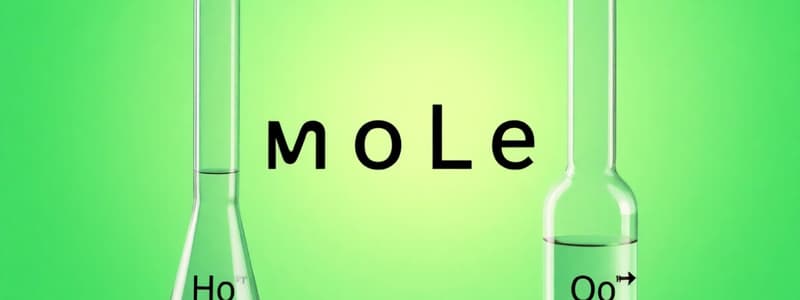Podcast
Questions and Answers
What does the term 'theoretical yield' refer to?
What does the term 'theoretical yield' refer to?
- The yield calculated based on incomplete reaction data
- The amount of product expected in a perfect scenario without losses
- The maximum amount of product that can be formed from given reactants (correct)
- The actual amount of product obtained in an experiment
How is percentage yield calculated?
How is percentage yield calculated?
- By dividing actual yield by theoretical yield and multiplying by 100 (correct)
- By multiplying actual yield by theoretical yield
- By subtracting actual yield from theoretical yield
- By dividing theoretical yield by actual yield
Which of the following fields utilize stoichiometry calculations?
Which of the following fields utilize stoichiometry calculations?
- Environmental science (correct)
- Astronomy
- English literature
- Culinary arts
What is a primary purpose of stoichiometry in chemical reactions?
What is a primary purpose of stoichiometry in chemical reactions?
What is the significance of the actual yield in a chemical experiment?
What is the significance of the actual yield in a chemical experiment?
What does stoichiometry primarily focus on in chemical reactions?
What does stoichiometry primarily focus on in chemical reactions?
Which statement about a balanced chemical equation is incorrect?
Which statement about a balanced chemical equation is incorrect?
In the reaction represented by the balanced equation 2H2 + O2 → 2H2O, what is the mole ratio of hydrogen to oxygen?
In the reaction represented by the balanced equation 2H2 + O2 → 2H2O, what is the mole ratio of hydrogen to oxygen?
What is the primary use of molar mass in stoichiometry?
What is the primary use of molar mass in stoichiometry?
What defines a limiting reactant in a chemical reaction?
What defines a limiting reactant in a chemical reaction?
Flashcards
Stoichiometry Definition
Stoichiometry Definition
Stoichiometry is calculating the amounts (moles, grams, or volume) of reactants and products in a chemical reaction using balanced equations.
Mole Ratio
Mole Ratio
The mole ratio is the relative amounts of reactants and products in a balanced chemical equation.
Limiting Reactant
Limiting Reactant
The reactant that is completely used up in a reaction and determines the maximum amount of product.
Mole Calculation
Mole Calculation
Signup and view all the flashcards
Mass-to-mass calculation in Stoichiometry
Mass-to-mass calculation in Stoichiometry
Signup and view all the flashcards
Theoretical Yield
Theoretical Yield
Signup and view all the flashcards
Actual Yield
Actual Yield
Signup and view all the flashcards
Percent Yield
Percent Yield
Signup and view all the flashcards
Stoichiometry in Manufacturing
Stoichiometry in Manufacturing
Signup and view all the flashcards
Stoichiometry in Pharmacy
Stoichiometry in Pharmacy
Signup and view all the flashcards
Study Notes
Introduction to Stoichiometry
- Stoichiometry is the calculation of relative quantities of reactants and products in chemical reactions.
- It's based on the law of conservation of mass, meaning that mass is neither created nor destroyed in a chemical reaction.
- It uses balanced chemical equations to determine the mole ratios of reactants and products.
Mole Concept
- A mole (mol) is a unit of measurement representing the amount of a substance.
- One mole of a substance contains Avogadro's number of particles (approximately 6.022 x 1023).
- The molar mass of a substance is the mass of one mole of that substance in grams.
Balanced Chemical Equations
- A balanced chemical equation represents a chemical reaction in terms of the formulas of the reactants and products, with the number of atoms of each element the same on both sides.
- Coefficients in a balanced equation represent the mole ratio of the reactants and products.
- Example: 2H2 + O2 → 2H2O (balanced equation)
Mole Ratios and Stoichiometric Calculations
- Mole ratios are derived from balanced chemical equations. They represent the relative amounts of reactants and products involved in the reaction.
- Using these ratios, one can determine the amount of one substance required to react with or to produce a specific amount of another substance. Examples include calculating moles, grams, or volumes.
- Example: In the reaction 2H2 + O2 → 2H2O, the mole ratio between hydrogen and water is 2:2, or simply 1:1
Calculating Quantities of Reactants and Products
- Mass-to-mass calculations: Use molar mass and mole ratios to find the mass of a product produced from a given mass of a reactant.
- Volume-to-volume calculations (for gases at STP): At standard temperature and pressure (STP), 1 mole of any ideal gas occupies 22.4 liters. This relationship allows calculations involving volumes of gases reacting or being produced.
- Mole-to-mole calculations: The coefficients in a balanced equation give the mole ratios directly. This is a cornerstone in stoichiometric calculations.
Limiting Reactants
- Not all reactants are used up in a reaction. The limiting reactant is the one that is completely consumed and limits the amount of product that can be formed.
- Excess reactants are those that are not completely consumed. The amount of product formed depends on the limiting reactant. Determining which reactant is the limiting reactant is part of most stoichiometric calculations.
Percent Yield
- The theoretical yield is the maximum amount of product that can be formed from a given amount of reactant(s).
- The actual yield is the amount of product actually obtained in a laboratory experiment.
- Percentage yield is the ratio of the actual yield to the theoretical yield, expressed as a percentage. This allows for assessing the efficiency of a chemical reaction.
Applications of Stoichiometry
- Stoichiometry calculations are vital in various fields:
- Industrial chemistry (manufacturing of chemicals)
- Environmental science (analyzing pollutants and waste)
- Pharmacy (compounding medications)
- Biochemistry (analyzing biological reactions)
- Geology (studying the composition of rocks and minerals)
- It's an essential tool to determine the optimal amounts of reagents for a desired product and to predict the outcome of chemical reactions in a controlled environment.
Studying That Suits You
Use AI to generate personalized quizzes and flashcards to suit your learning preferences.



